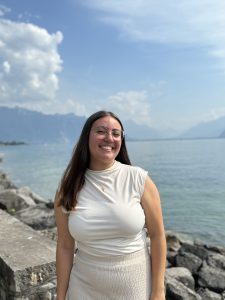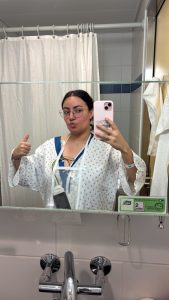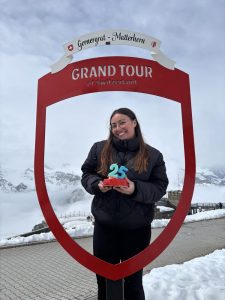When 25-year-old Juliana from Switzerland was diagnosed with Brugada Syndrome – a rare heart condition that can cause sudden cardiac arrest – she turned her fear and uncertainty into purpose, finding strength through connection and raising awareness to help others facing the same journey.
By: The SADS Foundation and Juliana M.
Published October 31, 2025 | 12 min read
“Doctors treat the condition, but they don’t always help you process the emotions that come with it.”
– Juliana
In February 2025, 25-year-old Juliana, who lives in Switzerland, was diagnosed with Brugada Syndrome – a rare and potentially life-threatening heart condition that can cause sudden cardiac arrest in otherwise healthy individuals.
Juliana’s journey began a few months earlier, in December 2024, when she experienced a strange heaviness in her chest while visiting a friend. “It felt like I couldn’t breathe and walk properly,” she recalls. Having had pneumonia several times as a child, she assumed it was another respiratory issue. But within two hours, her condition worsened – she developed a sudden fever, intense sweating, and dizziness. “I decided to go home, lay down, and the next thing I remember was waking up the next morning with no memory of what happened overnight.”
When she saw a doctor the following day, her fever was gone, but the physician noticed a slight pause in her heartbeat. “They asked if I had a heart disease or family history of one,” Juliana says. “I didn’t, so I thought maybe it was just a strange day.”
Two months later, while on holiday in London, the symptoms returned. Shortly after arriving, she developed a fever, began sweating, and struggled to breathe – symptoms she later learned can be triggered by Brugada Syndrome. She went back to her hotel and slept for hours, but when she woke in the middle of the night, she couldn’t feel her left arm. “I thought maybe I had slept on it wrong,” she says, “but it didn’t go away.”
At the hospital, she could barely walk or see through the sweat. An ECG revealed a concerning pattern – Type 1 Brugada Syndrome. “The doctor was very kind,” she says. “He prescribed medication to stabilize my symptoms and told me to return to Switzerland as soon as possible for a full diagnosis. I later learned he already suspected Brugada Syndrome, but chose not to tell me right away, he didn’t want to frighten me before it was sure.”
“The Uncertainty is the Hardest Part”
 When she landed back home, the symptoms struck again. Her boyfriend rushed her to the hospital, bringing the documents from London. At first, doctors in Switzerland doubted the diagnosis. “The nurses said it was impossible because I was too young,” Juliana explains. After hours of waiting, her boyfriend insisted she see a cardiologist – who confirmed that her case was serious.
When she landed back home, the symptoms struck again. Her boyfriend rushed her to the hospital, bringing the documents from London. At first, doctors in Switzerland doubted the diagnosis. “The nurses said it was impossible because I was too young,” Juliana explains. After hours of waiting, her boyfriend insisted she see a cardiologist – who confirmed that her case was serious.
Juliana was hospitalized for two weeks for continuous heart monitoring. “It was such a confusing time,” she says. “I saw five different doctors, and they all gave me different answers. Some said I needed an ICD immediately; others said to wait.” Eventually, the care team decided to implant a LINQ monitor to track her heart activity for a year before making a final decision about the ICD. Juliana is still waiting for answers about whether she needs a device.
“The nurses said a diagnosis of Brugada was impossible because I was too young.”
Through testing, Juliana learned that a cousin of her mother’s had died young from unknown causes -something that, in retrospect, might have been Brugada Syndrome.
“The uncertainty was the hardest part,” Juliana says. “Not the syndrome itself, but not knowing what would happen next.”
After her diagnosis, Juliana struggled to find doctors who truly understood Brugada Syndrome. If you or a loved one are in a similar situation, the SADS Foundation’s Physician Referral Network can help you connect with specialists experienced in genetic arrhythmia conditions. Learn more 👉
Building a Community
As one of the youngest patients in her cardiologist’s office, Juliana often feels isolated. “There are no Brugada Syndrome associations in Switzerland,” she says. “I didn’t know who to talk to. I didn’t want to call my cardiologist every time I had a question.”
question.”
At one point, doctors told her parents that she could die at any moment. “It was really scary,” she remembers. “Doctors treat the condition, but they don’t always help you process the emotions that come with it.”
That emotional gap – “the in-between,” as she calls it – has been one of her greatest challenges. “I’m not sick in the way people imagine,” she explains. “But I’m also not carefree. I’m alive, and though things feel different, I’ve learned to live deeply within that difference.”
Through our peer support program, patients and families can find others who share their experiences – a lifeline of understanding and support during uncertain times. Connect with peer support 👉
Since her diagnosis, Juliana has found purpose in raising awareness about Brugada Syndrome. “I believe awareness can save lives,” she says. “Many people are misdiagnosed or dismissed, just like I was at first.”
Unable to find any Swiss organizations focused on Brugada Syndrome, she began reaching out internationally to volunteer and connect with others who understand. That’s when she connected with the SADS Foundation, where she now is sharing her story and volunteering to help others with Brugada.
“When you don’t have a community, you have to build one,” she says. “If sharing my story helps even one person find hope a little sooner, then it will all have been worth it.”
From emotional support to practical tools and education, our programs help individuals and families live confidently with genetic heart conditions. Learn more at sads.org.
👉 Want to connect others with Brugada Syndrome? Learn more here →
Need help now? Connect with our Family Support Team for referrals, resources, and community.
Contact | Get Support | Donate
